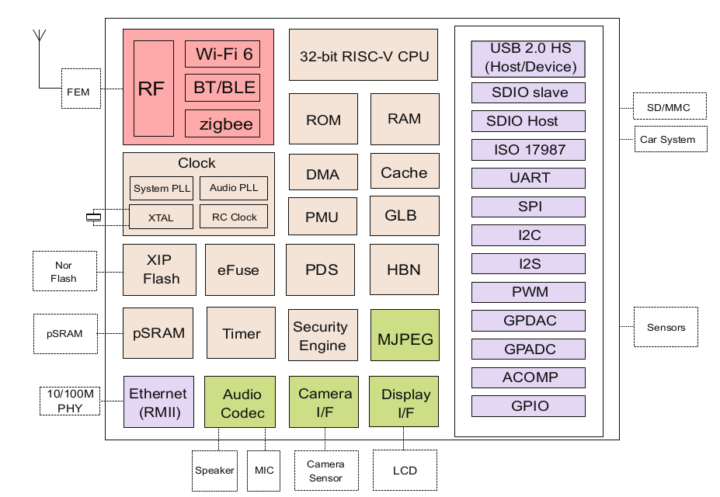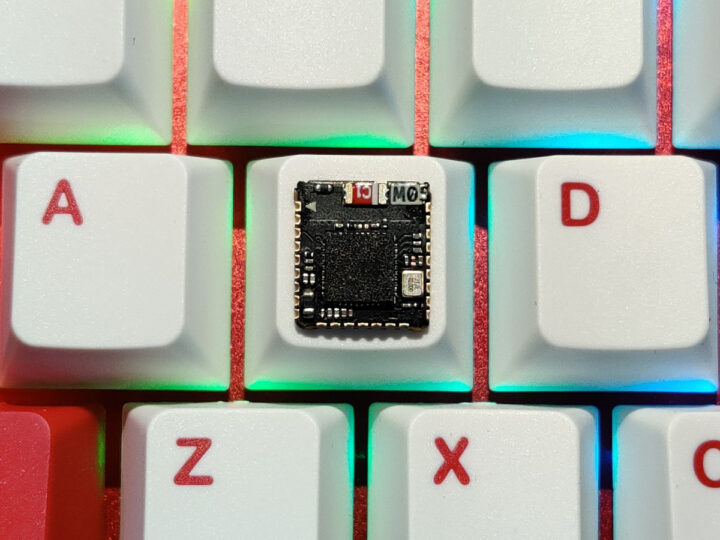Bouffalo Lab BL616/BL618 is a 32-bit RISC-V wireless microcontroller with support for 2.4 GHz WiFi 6, Bluetooth 5.2 dual-mode, and an 802.15.4 radio for Zigbee, Thread, and Matter designed for IoT applications.
We first spotted the BL616 RISC-V IoT MCU during the BL602/BL606 announcement in November 2020, but we had virtually no additional information about it so far. It appears both BL616 and BL618 will be launched next month with the main difference between the two being that BL616 has 19 GPIOs and BL618 comes with 35 GPIOs.

Bouffalo Lab BL616 and BL618 specifications:
- MCU core – 32-bit RISC-V CPU (RV32IMAFCP) @ up to 320 MHz with FPU and DSP, 32KB instruction cache & 16KB data cache
- VPU – MJPEG video encoder
- Memory – 480KB SRAM, 4KB HBN RAM, embedded 4 or 8MB pSRAM (optional)
- Storage – 128KB ROM, 4Kb eFuse, embedded 2, 4, or 8MB flash (optional), XIP QSPI flash support, SD card interface
- Wired networking – 10/100M Ethernet
- Wireless
- 2.4 GHz RF transceiver
- Wi-Fi 6 (IEEE 802.11 b/g/n/ax) 1T1R up to 229.4 Mbps
- Bluetooth 5.x dual-mode (classic + LE)
- Zigbee / IEEE 802.15.4
- WiFi features
- STA, SoftAP, STA+SoftAP, and sniffer modes
- Security – WPS, WEP, WPA, WPA2, WPA3
- LDPC, STBC, Beamforming, DL/UL OFDMA, MU-MIMO, TWT (Target Wake Time), SR(Spatial Reuse), DCM (Dual Carrier Modulation), ER (Extended Range)
- IEEE 802.11e QoS WMM (Wi-Fi MultiMedia), IEEE 802.11w PMF (Protected Management Frames)
- Display I/F – QSPI and DBI interfaces for LCD display
- Camera – DVP interface
- Audio Codec
- 1x ADC (MIC, SNR > 92dB)
- 1x DAC (Speaker, SNR > 95dB)
- Sampling rates – 8, 12, 16, 22.05, 24, 32, 44.1, 48KHz
- Peripherals
- USB – USB 2.0 HS OTG up to 480Mpbs
- SDIO 2.0 slave
- 2x UART (Support 5V IO)
- 2x I2C with host mode support
- SPI master/slave
- I2S master/slave
- 1x PWM (4-channel)
- 12~16-bit general-purpose ADC
- 10-bit general-purpose DAC
- RTC timer
- 2x 32-bit general-purpose timers
- 4x DMA channels
- General analog comparators (ACOMP)
- GPIO – Up to 19x for BL616, up to 35x for BL618
- Security
- Secure boot; Secure debug
- XIP QSPI On-The-Fly AES Decryption (OTFAD)
- Support sensitive SW isolation (TrustZone)
- AES-CBC/CCM/GCM/XTS modes
- MD5, SHA-1/224/256/384/512
- TRNG (True Random Number Generator)
- PKA (Public Key Accelerator) for RSA/ECC
- Clock
- Support XTAL 24/26/32/38.4/40MHz
- Support XTAL 32.768KHz
- Internal RC 32KHz & 32MHz oscillator
- Internal System & Audio PLL
- Debugging – JTAG development support
- Power Modes (Ultra-low Power modes)
- Off ; Hibernate (<1uA)
- Power Down Sleep (flexible)
- Package Type
- 40-pin QFN (BL616)
- 56-pin QFN (BL618)
Bouffalo BL616 and BL818 are supported by the latest version of the open-source bl_mcu_sdk MCU software development kit available on GitHub. You can download the datasheet and reference manual for more details about the microcontrollers. While the new Matter protocol is not mentioned in any of the documents, Bouffalo Lab will be using BL616 for WiFi Matter, BL618 in both Matter border routers and bridges.

The BL616/8 was brought to my attention by Sipeed who is planning to launch the tiny (11x10mm) M0S module by mid-January 2023. The M0S is based on the BL616 RISC-V microcontroller @ up to 384 MHz with WiFi 6, Bluetooth 5.2, and Zigbee, 4MB flash, 512KB SRAM, a ceramic antenna, USB 2.0, and a few other I/Os. Sipeed expects to sell it for less than $2 at launch. You can find more details about the module on Twitter.

Jean-Luc started CNX Software in 2010 as a part-time endeavor, before quitting his job as a software engineering manager, and starting to write daily news, and reviews full time later in 2011.
Support CNX Software! Donate via cryptocurrencies, become a Patron on Patreon, or purchase goods on Amazon or Aliexpress





The 32bit riscv cpu in this bl616/bl618 looks a lot like one of the cpu cores inside bl808 (found in pine64 0x64)
I know you brought up the esp32-c6 ~1.5 years ago, and I had been to their site which showed they also use 802.15.4 (not mentioned in their news 1.5 years ago). It still doesn’t look like it’s for sale. I’ve been exploring Matter a little, and my nrf52840 is only capable of BT+802.15.4, while my esp32-c3 is only capable of 802.11+802.15.4. I thought it’s be nice to have the whole gamut met with 802.11+802.15.4+BT. I’m wondering/hopeful I can use a single low-power device as a standalone Matter border router/bridge/gateway/whatever, whereby I could communicate it via a PC of some sort… Read more »
As far as I know the ESP32-C3 does not support the 802.15.4 protocols (Zigbee, Matter…), only WiFi and BT, did I miss something? The only chip in the series with 802.15.4 support is the -H2 announced a very long while back but still not available.
Matter runs just fine on wifi. 802.15.4 Thread is an optional transport.
When talking to other devices running Matter over WiFi or with a bridge somewhere, surely. But many power-constrained devices will only run on 802.15.4, and I believe that’s the point being discussed here, otherwise any of the existing ESP32 chips will do.
Here’s a Matter to BLE Mesh bridge ready to go..
https://github.com/espressif/esp-matter/tree/main/examples/blemesh_bridge
Interesting. I’ll have to take a look.
Seeing as it’s for the c3, I’d only be able to communicate with other Matter BT/802.11 devices.
I wonder if I’ll be able to port it to my nrf52840 and use the Android chip-tool to communicate (dunno if the chip-tool only goes over 802.11)…
It runs on every ESP32 with BLE and wifi.
Run BLE mesh on your nrf52840, you can download it from Nordic.
Agh, yeah, I had meant 802.11+BT for c3. I had that correct in posts elsewhere.
If it were 802.11+802.15.4, then I’d think I could use that as a standalone border router.
You don’t really need to build 802.15.4 border routers. Most Google Home, Amazon Echo, and Apple Homepod are 802.15.4 border routers (if fairly recent vintage). Much easier just to buy one of those. Echo’s can be as cheap as $25.
Very interesting, definitely being made to allow for Matter devices.
The firmware for the nRF52840 Matter samples are like 700-900kb.
All the Matter Samples for the nRF52840 use a SPI Flash chip, that is also present on the nRF52840-DK
Something feels kind-of lop-sided with this chip. Why are there a bunch of radios supported but there’s only one core? External XiP QSPI storage support exists but I think it will be lonely too without that second core, especially in ML applications. Then it supports On-The-Fly AES decryption but no OTF AES encryption; so I guess all two-way communications are going to be highly asymmetric? From the the Twitter thread it says the chip will support Python scripting out-of-the-box (I’m assuming it’s really MicroPython) which IMO is a mistake (yeah the ML obsession pivots on Python). For obvious reasons (speed… Read more »
The “on the fly” decryption is for loading encrypted firmware blocks, not for communication.
Also it needs QSPI XIP because there is no on-die flash.
I’m pretty sure it doesn’t have trustzone, because that is an arm technology (and trademark!).
This device is pretty much an ESP32 with some slightly different peripherals and a slightly faster clock speed. As always, these new devices are useless without good documentation and BSP, and I’m yet to see anything super compelling from these BL devices.
Yeah, espressif’s alternative – even if would use two esp32 – is probably better to work with due to far superior documentation
Also, 4 dma channels seems low..
True, specs are nice, but whitout a good BSP/SDK its useless, and the Bouffalo docs seem to be minimal and chineese.
Do any of the ESP32s have an audio codec?
Btw riscv64 toolchain is looking for a debian maintainer:
https://bugs.debian.org/cgi-bin/bugreport.cgi?bug=1015206
Instruction set is not RV32GCP because it has no double precision floating point. “Only” RV32IMAFCP instruction set.
These chips sound interesting and I’ve benchmark’d one at 1111 coremarks/s which is more than twice the speed of a single esp32 core and even slightly faster than a dual core esp32. Also the SD card interface looks promising at over 18 MBytes/s while reading.
The EHCI USB host controller is the most promising feature but the examples from the SDK are incomplete and don’t work very reliable. Related support requests are denied and closed.
Overall a promising device but unfortunately with major support problems.